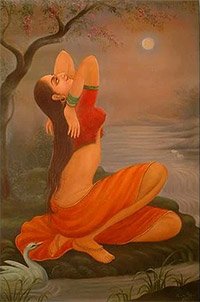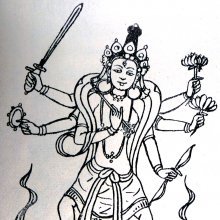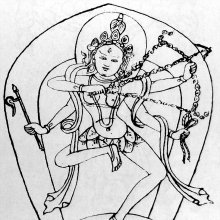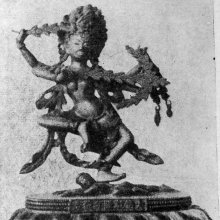Vashikarana, Vaśīkaraṇa: 18 definitions
Introduction:
Vashikarana means something in Hinduism, Sanskrit, Jainism, Prakrit, Buddhism, Pali, Hindi. If you want to know the exact meaning, history, etymology or English translation of this term then check out the descriptions on this page. Add your comment or reference to a book if you want to contribute to this summary article.
The Sanskrit term Vaśīkaraṇa can be transliterated into English as Vasikarana or Vashikarana, using the IAST transliteration scheme (?).
Alternative spellings of this word include Vashikaran.
Images (photo gallery)
In Hinduism
Shaktism (Shakta philosophy)
Source: Google Books: ManthanabhairavatantramVaśīkaraṇa (वशीकरण) refers to the “power to control and subjugate”, according to sources such as the Kulakaulinīmata and Kumārikākhaṇḍa of the Manthānabhairavatantra.—Although the text does not say so, it is clear that the red Nityā is a form of Kāmeśvarī. She both looks almost the same and grants the same boon, that is, the power to be irresistibly attractive to women. When Nityā is in her black form, she is Kālī. Surrounded by the same Yoginīs, the power to attract women becomes ‘the great force of delusion’ (mahāvega, bhramavega) by means of which the adept can control and even kill his enemies. All forms of magic are based essentially on the power to control and subjugate (vaśīkaraṇa). ‘Black’ rites direct this power at enemies, ‘red’ rites subjugate women and ‘white’ ones are the means to achieve control of higher, spiritual powers.

Shakta (शाक्त, śākta) or Shaktism (śāktism) represents a tradition of Hinduism where the Goddess (Devi) is revered and worshipped. Shakta literature includes a range of scriptures, including various Agamas and Tantras, although its roots may be traced back to the Vedas.
Kavya (poetry)
Source: Brill: Śaivism and the Tantric Traditions (kavya)Vaśīkaraṇa (वशीकरण) refers to “snaring (women) (using magic powders)”, according to Bāṇa’s Kādambarī (p. 226).—There are apparently several Tantric rites that Bāṇa pejoratively associates with the priest: [...] “his ear-cavities were punched by those possessed by Piśāca-demons, who had run to him when struck by white mustard seed he had empowered with mantras more than once”; “he had used magic powders for snaring women (strī-vaśīkaraṇa) many times on aging mendicant ladies, who having arrived from other lands retired [there to rest]”.

Kavya (काव्य, kavya) refers to Sanskrit poetry, a popular ancient Indian tradition of literature. There have been many Sanskrit poets over the ages, hailing from ancient India and beyond. This topic includes mahakavya, or ‘epic poetry’ and natya, or ‘dramatic poetry’.
Ayurveda (science of life)
Source: archive.org: Science And Technology In Medievel India (Ayurveda)Vasikaraṇa (वसिकरण) is the name of a chapter of the Kalpacintāmaṇi.—The work is mentioned in A. Rahman’s Science and Technology in Medievel India: A bibliography of source materials in Sanskrit, Arabic and Persian.—Ancient and medieval India produced a wide range of scientific manuscripts and major contributions lie in the field of medicine, astronomy and mathematics, besides covering encyclopedic glossaries and technical dictionaries.—Vasikaraṇa-prayoga and other chapters of the Kalpacintāmaṇi (also known as Kalpasāgara) deal with sorcery and preparation of patent medicines.

Āyurveda (आयुर्वेद, ayurveda) is a branch of Indian science dealing with medicine, herbalism, taxology, anatomy, surgery, alchemy and related topics. Traditional practice of Āyurveda in ancient India dates back to at least the first millenium BC. Literature is commonly written in Sanskrit using various poetic metres.
Pancaratra (worship of Nārāyaṇa)
Source: archive.org: Catalogue of Pancaratra Agama TextsVaśīkaraṇa (वशीकरण) refers to the “method of subdue other people”, as discussed in the second chapter [fifth book] of the Jñānāmṛtasārasaṃhita: a Pāñcarātra text representing a sectarian glorification of Kṛṣṇa and Rādha (i.e., the cult of Radha-Krishna) dated among the latest of the Saṃhitā-type works.—Description of the chapter [mudrānirūpaṇa]: Śiva tells here how to subdue [vaśīkaraṇa] other people with the help of 10-syllable and 18-syllable mantras spoken of in the preceding chapter. The first part of the chapter deals with how different degrees of japa, different types of homas, and different kinds of dhyāna can be combined and varied to achieve different “prayogic” effects (1-22). [...]

Pancaratra (पाञ्चरात्र, pāñcarātra) represents a tradition of Hinduism where Narayana is revered and worshipped. Closeley related to Vaishnavism, the Pancaratra literature includes various Agamas and tantras incorporating many Vaishnava philosophies.
Kama-shastra (the science of Love-making)
Source: Shodhganga: Influence of Kamasastra on classical Sanskrit literatureVaśīkaraṇa (वशीकरण) or Vaśīkaraṇatantra is the name of a text dealing with Kāmaśāstra as referenced by the Kelikutuhala by Pandita Mathura Prasada Dixit—The Kelikutūhala is a recent erotic book written in 1949 A.D. discussing topics such as masturbation, use of medicines, coital postures, prostitution, etc.. In the introduction to this book the author gives a list 64 of fifty books [e.g., vaśīkaraṇa-tantra] which were written on erotic science in which most of the books are unpublished. All these books show the rich heritage of Indian erotic science (kāma-śāstra).

Kamashastra (कामशास्त्र, kāmaśāstra) deals with ancient Indian science of love-making, passion, emotions and other related topics dealing with the pleasures of the senses.
In Jainism
General definition (in Jainism)
Source: academia.edu: Tessitori Collection IVaśīkaraṇa (वशीकरण) refers to “bringing other people into one’s own power” (using the sahadevī plant), according to a manuscript (dealing with Hymns to the Jinas, sahadevīkalpa and yantra usages), which is included in the collection of manuscripts at the ‘Vincenzo Joppi’ library, collected by Luigi Pio Tessitori during his visit to Rajasthan between 1914 and 1919.—[...] Unit 3 deals with the uses of the sahadevī plant (Vernonia cinerea liss., purple feabane), alone or in association with other substances. It can be swallowed, put on the body or worn as amulet. This plant is ascribed curative abilities in Āyurveda as a febrifuge or a means to cure dysentery for instance. In Tantra it is said to bring other people into one’s own power (vaśīkaraṇa). All these capacities are dealt with here.

Jainism is an Indian religion of Dharma whose doctrine revolves around harmlessness (ahimsa) towards every living being. The two major branches (Digambara and Svetambara) of Jainism stimulate self-control (or, shramana, ‘self-reliance’) and spiritual development through a path of peace for the soul to progess to the ultimate goal.
Languages of India and abroad
Sanskrit dictionary
Source: DDSA: The practical Sanskrit-English dictionaryVaśīkaraṇa (वशीकरण).—
1) Fascinating, attracting.
2) A cause of attraction or allurement; एकैकमेव हि वशीकरणं गरीयः (ekaikameva hi vaśīkaraṇaṃ garīyaḥ) Mālatīmādhava (Bombay) 6.17.
3) Subduing, subjugation.
Derivable forms: vaśīkaraṇam (वशीकरणम्).
Source: Cologne Digital Sanskrit Dictionaries: Shabda-Sagara Sanskrit-English DictionaryVaśīkaraṇa (वशीकरण).—n. (-ṇa) 1. Subduing or overcoming by drugs, charms, &c., enchanting, charming. 2. Subduing in general. E. vaśa subduing, and karaṇa making, cvi augment, leaving ī.
Source: Cologne Digital Sanskrit Dictionaries: Benfey Sanskrit-English DictionaryVaśīkaraṇa (वशीकरण).—i. e. vaśa-kṛ + ana, 1. Subduing in general, [Pañcatantra] i. [distich] 80. 2. Subduing by magical expedients.
Source: Cologne Digital Sanskrit Dictionaries: Cappeller Sanskrit-English DictionaryVaśīkaraṇa (वशीकरण).—[neuter] [abstract] to [preceding]
Source: Cologne Digital Sanskrit Dictionaries: Monier-Williams Sanskrit-English DictionaryVaśīkaraṇa (वशीकरण):—[=vaśī-karaṇa] [from vaśī > vaś] n. the act of making subject, subjugating, bewitching (by means of spells etc.), overcoming by charms and incantations etc. (with [genitive case] or ifc.), [Pāraskara-gṛhya-sūtra; Rāmāyaṇa; Pañcatantra etc.]
Source: Cologne Digital Sanskrit Dictionaries: Yates Sanskrit-English DictionaryVaśīkaraṇa (वशीकरण):—[vaśī-karaṇa] (ṇaṃ) 1. n. Subduing or overcoming by drugs, &c.
Source: DDSA: Paia-sadda-mahannavo; a comprehensive Prakrit Hindi dictionary (S)Vaśīkaraṇa (वशीकरण) in the Sanskrit language is related to the Prakrit word: Vasīkaraṇa.
[Sanskrit to German]
Sanskrit, also spelled संस्कृतम् (saṃskṛtam), is an ancient language of India commonly seen as the grandmother of the Indo-European language family (even English!). Closely allied with Prakrit and Pali, Sanskrit is more exhaustive in both grammar and terms and has the most extensive collection of literature in the world, greatly surpassing its sister-languages Greek and Latin.
Hindi dictionary
Source: DDSA: A practical Hindi-English dictionaryVaśīkaraṇa (वशीकरण) [Also spelled vashikaran]:—(nm) fascinating or enchanting into submission/control; ~[kṛta] fascinated/enchanted into submission; ~[karaṇa-maṃtra] a conjuration to bring (someone) under complete sway.
...
Prakrit-English dictionary
Source: DDSA: Paia-sadda-mahannavo; a comprehensive Prakrit Hindi dictionaryVasīkaraṇa (वसीकरण) in the Prakrit language is related to the Sanskrit word: Vaśīkaraṇa.
Prakrit is an ancient language closely associated with both Pali and Sanskrit. Jain literature is often composed in this language or sub-dialects, such as the Agamas and their commentaries which are written in Ardhamagadhi and Maharashtri Prakrit. The earliest extant texts can be dated to as early as the 4th century BCE although core portions might be older.
Kannada-English dictionary
Source: Alar: Kannada-English corpusVaśīkaraṇa (ವಶೀಕರಣ):—
1) [noun] a bringing another person under one’s control using magical rites and charms.
2) [noun] the art of this.
Kannada is a Dravidian language (as opposed to the Indo-European language family) mainly spoken in the southwestern region of India.
Nepali dictionary
Source: unoes: Nepali-English DictionaryVaśīkaraṇa (वशीकरण):—n. overpowering; subjugating; enchanting;
Nepali is the primary language of the Nepalese people counting almost 20 million native speakers. The country of Nepal is situated in the Himalaya mountain range to the north of India.
See also (Relevant definitions)
Partial matches: Vasi, Yu, Kaara, Karana, Vasa, Vaca, Kara, Vaci.
Starts with: Vashikaranadividhi, Vashikaranastotra, Vashikaranatantra, Vashikaranaushadha, Vashikaranavarahimantra.
Query error!
Full-text (+4): Vashikaranastotra, Vasikaranapanaka, Vashikaranatantra, Vasikara, Vacikaran, Karmanatva, Vacikaranam, Mantramula, Vashikaran, Mudranirupana, Mantra, Madhu, Malati, Candrasena, Lilavati, Manohara, Tarana, Bhrama, Bhramavega, Barhicuda.
Relevant text
Search found 36 books and stories containing Vashikarana, Vasa-kara-yu, Vashi-karana, Vaśī-karaṇa, Vasi-karana, Vasī-karaṇa, Vaśīkaraṇa, Vasikarana, Vasīkaraṇa, Vaśikaraṇa; (plurals include: Vashikaranas, yus, karanas, karaṇas, Vaśīkaraṇas, Vasikaranas, Vasīkaraṇas, Vaśikaraṇas). You can also click to the full overview containing English textual excerpts. Below are direct links for the most relevant articles:
Garga Samhita (English) (by Danavir Goswami)
Verses 4.11.19-20 < [Chapter 11 - The Story of the Gopīs that were Residents of...]
Sahitya-kaumudi by Baladeva Vidyabhushana (by Gaurapada Dāsa)
Text 10.144 < [Chapter 10 - Ornaments of Meaning]
Notices of Sanskrit Manuscripts (by Rajendralala Mitra)
Kavyamimamsa of Rajasekhara (Study) (by Debabrata Barai)
Part 2.3 - Genesis of Sāhitya-vidyā (literart criticism) < [Chapter 5 - Analyasis and Interpretations of the Kāvyamīmāṃsā]
World Journal of Pharmaceutical Research
Review on arkaprakash < [2021: Volume 10, November issue 13]
Literary review of patha and stanyashodhana in Samhita. < [2021: Volume 10, July issue 8]
A critical review on lepa kalpana with special reference to mukha lepa < [2021: Volume 10, April issue 4]
Shaivacintamani (analytical study) (by Swati Sucharita Pattanaik)
Part 6 - Dakṣiṇaliṅgamūrti-Liṅga < [Chapter 3: Śaiva tradition and Śaivacintāmaṇi]
Part 10 - Items Used For Śiva Abhiṣeka Are < [Chapter 3: Śaiva tradition and Śaivacintāmaṇi]
Part 18 - The Worship of Lord Śiva By Chanting Vedic Mantras < [Chapter 3: Śaiva tradition and Śaivacintāmaṇi]


